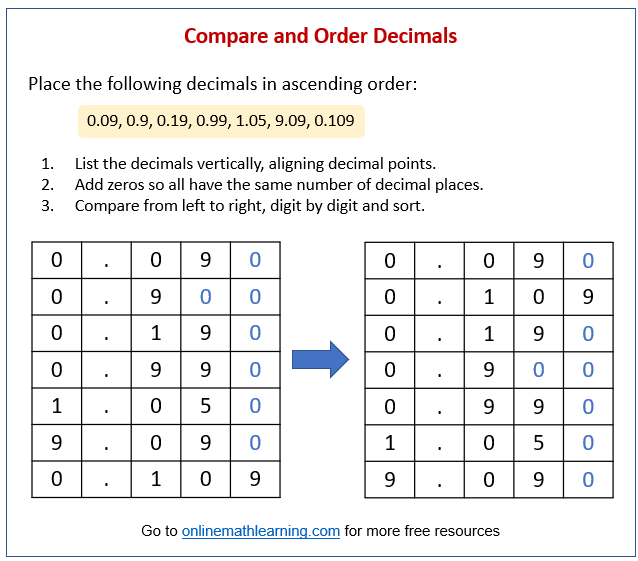Comparing and Ordering Decimals
Related Topics:
More Lessons for Grade 5
Math Worksheets
Examples, solutions, videos, worksheets, stories, and songs to help Grade 5 students learn how to compare and order decimals.
Comparing and ordering decimals involves determining the relative size of two or more decimal numbers. Decimals are compared digit by digit from left to right, just like whole numbers, but with attention to the decimal point.
The following diagram gives some examples of comparing and ordering decimals. Scroll down the page for more examples and solutions.

Decimal Worksheets
Practice your skills with the following worksheets:
Online & Printable Decimal Worksheets
Steps for Comparing Two Decimals:
- Compare the Whole Number Part: Look at the digits to the left of the decimal point.
If the whole number parts are different, the decimal with the larger whole number is the greater decimal.
Example: 3.14 is greater than 2.89 because 3 is greater than 2. - Align the Decimal Points: If the whole number parts are the same, align the decimal points of the numbers vertically. This helps in comparing the digits in the same place value.
- Compare the Digits in Each Place Value from Left to Right: Starting from the tenths place (the first digit to the right of the decimal), compare the digits in each corresponding place value.
If the digits in a certain place value are different, the decimal with the larger digit in that place value is the greater decimal. - Use Trailing Zeros as Placeholders: If one decimal has fewer digits after the decimal point than the other, you can add trailing zeros to the shorter decimal without changing its value. This can make comparison easier.
Steps for Ordering Multiple Decimals:
- List the decimals vertically, aligning decimal points.
- Add zeros so all have the same number of decimal places.
- Compare from left to right, digit by digit and sort.
First, compare the whole number parts. Order the decimals based on their whole number parts.
If the whole number parts are the same, move to the tenths place and order based on those digits.
If the tenths digits are also the same, move to the hundredths place, and so on.
Continue this process until you have ordered all the decimals.
Key Principles:
- Place Value Matters: The position of a digit after the decimal point determines its value. The further to the right, the smaller the place value.
- Left-to-Right Comparison: Start comparing from the largest place value (leftmost) and move towards the smallest (rightmost).
- Trailing Zeros Don’t Change Value: Adding zeros to the end of a decimal does not change its value and can help in comparison.
Common Mistakes to Avoid
Misaligned decimals: Always line up the decimal point
Ignoring negative signs: −0.6 is less than −0.2.
Overlooking trailing zeros: 0.7 = 0.70.
Comparing and arranging decimals
This is a short video tutorial on comparing and arranging decimals.
Decimals Comparing and Ordering
Comparing Decimals with Less Than and Greater Than
A song on how to use the > and < symbols.
The hungry alligator
eats the value that is greater.
The value that is least
is never part of his feast.
Comparing decimals: ordering from least to greatest
Try out our new and fun Fraction Concoction Game.
Add and subtract fractions to make exciting fraction concoctions following a recipe. There are four levels of difficulty: Easy, medium, hard and insane. Practice the basics of fraction addition and subtraction or challenge yourself with the insane level.

We welcome your feedback, comments and questions about this site or page. Please submit your feedback or enquiries via our Feedback page.